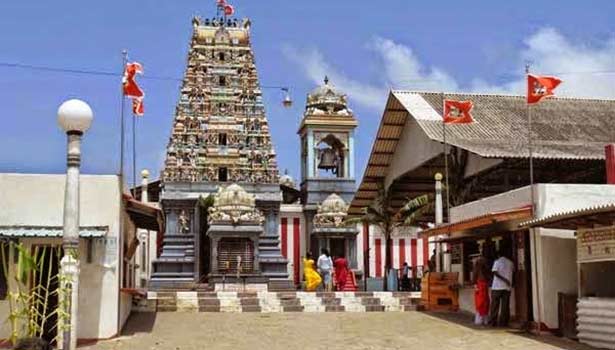Sri Thiruketheeswaram (Ketheeswaram ) Temple, Sri Lanka

Address
Sri Thiruketheeswaram( Ketheeswaram ) Temple, Navathkuli Karativu – Mannar Hwy, Thiruketheeswaram, Sri Lanka Phone: +94 232 050 800Telephone No : 0232233003, 0112360316, 0112582890, 0112586042
Deity
Thiruketheeswaramn, Ketheeswaram Amman: Gowri
Introduction
Thiruketheeswaram Temple – An Ancient Hindu Shrine in Sri Lanka
Historical Significance:
- Location: Mannar, Northern Province, Sri Lanka.
- Part of Pancha Ishwarams: One of five ancient coastal kovils dedicated to Lord Shiva in Sri Lanka.
- Overlooks: The ancient Tamil port towns of Manthai and Kudiramalai.
- Estimated Age: At least 2,400 years old, though the exact origin remains unknown.
- Historical City: Located near the long-buried city of Manthottam, a former Hindu trade center.
Destruction & Reconstruction:
- 16th Century: The temple was destroyed during the Portuguese invasion.
- 20th Century: Rebuilt nearly 400 years later.
- 1950s: Further renovated with the support of the Thiruketheeswaram Restoration Society.
Legends & Mythological Links:
- Ramayana Connection:
- According to the Ramayana, Ravana’s wife hailed from Manthai, where her father built Thiruketheeswaram in honor of Lord Shiva.
- Skanda Purana Connection:
- The Skanda Purana narrates that the God of Wind (Vayu) uprooted the three towers of Maha Meru Mountain in Indonesia and dropped one at Thiruketheeswaram.
- Paadal Petra Sthalam:
- Recognized as one of the 275 Shiva temples glorified in the Thevaram hymns.
Religious & Cultural Importance:
- One of the Most Venerated Hindu Temples in Sri Lanka.
- Highly revered by Shaivites across the Indian subcontinent.
- Connected to the Ramayana Trail in Sri Lanka.
Puranic Significance
Mythological Stories of Thiruketheeswaram Temple
1. Connection to Ravana and Mandodari
According to the Ramayana, Mandodari, the wife of King Ravana, hailed from Manthai. Her father, Mayan, the King of Manthai, is said to have built Thiruketheeswaram Temple to worship Lord Shiva. This establishes a strong link between the temple and Lanka’s ancient rulers.
2. Worship by Sage Bhrigu and Ketu
- Maharishi Bhrigu, one of the great sages in Hinduism, is believed to have worshipped Shiva at this shrine.
- The Hindu planetary god Ketu also performed penance here, leading to the temple being named “Ketheeswaram”. It is believed that bathing in the sacred Palavi Theertham and worshiping Shiva here removes Rahu and Ketu doshas in one’s horoscope.
3. Mention in the Skanda Purana
- The Skanda Purana, an ancient Sanskrit text with 2,500 verses across 27 chapters, contains three chapters under the title Dakshina Kailasa Manmiam, which narrate the sacred history of Ceylon (Sri Lanka).
- The second chapter speaks of Thiruketheeswaram and its divine origins.
- It describes how the God of Wind (Vayu) uprooted three towers of Maha Meru Mountain to counter the demon Athichedan, who obstructed the mountain with thousands of serpent-like peaks. One of these towers landed at Thiruketheeswaram, where Lord Shiva established Himself.
4. One of the Nine Most Sacred Sthalams
- Thiruketheeswaram and Koneswaram are among the nine most sacred Hindu sthalams. The other seven are located in India.
- Sage Agastya, while traveling to the South (Tendisai), stopped at Thiruketheeswaram to worship Lord Shiva before visiting Koneswaram.
5. The Power of Palavi Theertham
- It is believed that bathing in Palavi Theertham washes away sins accumulated over multiple lifetimes.
- Performing Pitru Puja here is considered highly auspicious, and it is said that ancestors’ blessings are directly received.
6. The Lingam Brought by Lord Rama
- One of the three Shiva Lingams received by Lord Rama is worshiped at this temple.
- The temple is linked to the Ramayana Trail in Sri Lanka, as Ravana and Mandodari’s lineage are closely associated with the site.
7. Worship of Naga Tribes & Lord Naganathar
- The ancient Naga tribes of Sri Lanka are believed to have worshiped Lord Shiva here.
- Due to their worship, Lord Shiva is also called Naganathar at this temple.
Beliefs
It is said that those who bathe in the Balavith Tirtha, which is located in this place, will get blessings and those who bathe in this Tirtha will get rid of sins like Pramakathi.
Special Features
According to the Manmiam, Thiruketheeswaram along with Koneswaram are two of the nine most sacred sthalams of the Hindus. The other seven are in India. There is a huge statue of Somaskandar in the world. The temple was built by the Cholas. The temple was destroyed in 1600. Is being updated again. It is the 269th shrine out of the 274 shrines to receive the devotional song of Lord Shiva. .
Festivals
The Thiruketheeswaram Kovil in Mannar comes alive with lights and activity especially during Maha Shivaratri – a festival celebrated each year in reverence of Lord Shiva. During this festival, the Shiva temple is flocked by many devotees from all over the country both young and old, who come to perform the traditional Shivalinga Pooja or to worship and hence hope for favours from the deity. At sunrise the devotees cleanse themselves in the traditional Palavi, a tank which is next to the temple. This is a significant purificatory right adhered to at all Hindu festivals. Then the worshippers carry pots of water to the temple with which they bathe the Shiva Lingam.
Century/Period/Age
1000-2000 years old
Managed By
Government of Srilanka
Nearest Bus Station
Thiruketheeswaram
Nearest Railway Station
Colombo
Nearest Airport
Colombo









